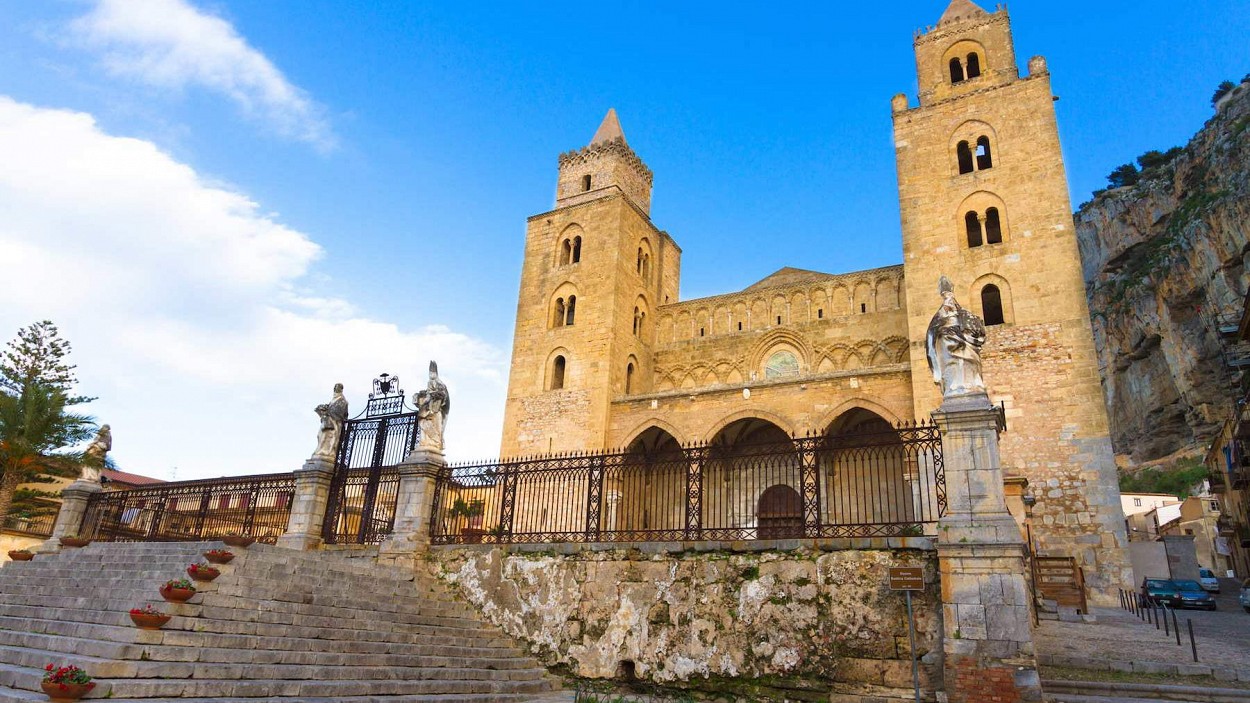Cefalù
Located in an exceptional location, visible from the road that leads from Palermo, Cefalù is a fishing village between the sea and a limestone bluff, proud of its Romanesque cathedral that emerges from a tangle of narrow streets. Citizen of Greek origin, from which it takes its name, Kephaloidion. head or chief, knows its heyday under the Normans and in particular Roger II who in 1131 decided to have screwed the construction of the cathedral.
Corso Ruggero Cefalù main retraces the ancient Roman decumanus which bisects the city from north to south. The two zones that are created are morphologically different: in the west, the medieval quarter, a warren of narrow steps, arches and narrow passages in the east a regular layout of streets perpendicular and regular. It 's likely that the difference corresponded to two different social classes to which the districts were intended: the western to the people: the east to the nobility and the clergy.
The course starts from Piazza Garibaldi, where was one of four city gates. On the square is the Baroque Church of St.. Maria alla Catena, whose bell tower includes the remains of the ancient megalithic walls.
Osteria Magno - The legendary home of King Roger, later belonged to the Ventimiglia family, consists of two parts of different ages. Oldest is the colored side (lava stone and gold) that overlooks Via Amendola, with two elegant mullioned windows dating from the end of '200. Adjacent to this, the corner of Corso Ruggero, the square tower, built in 300 and has a fine three-light window into an elaborate Chiaramonte-style arch. The palace, now fully restored and is used for temporary exhibitions.
Later, on the right is the Church of the Purgatory (formerly St. Stephen the Martyr), whose facade features a Baroque portal, is preceded by a fine stairway. Upon entering on the right is the tomb of Baron Mandralisca (see the eponymous museum). Towards the end of the street widens supiazza del Duomo, dominated by the cathedral and surrounded by beautiful buildings: the Palazzo Piraino (corner with Corso Ruggero) who maintains a portal late sixteenth century, the medieval Palazzo Maria, perhaps a royal residence, has a Gothic and, on the left of the cathedral, the Bishop's Palace (XVII sec.).
Duomo - The golden stone of this Romanesque jewel on which stands the profile of a few palm trees, is indistinguishable from the limestone cliff called La Rocca. The building was built between 1131 and 1240 following a vote of the Norman king Roger II on the verge of making shipwreck on his return from Naples. More than that of Norman Palermo has a very obvious character which is primarily expressed in the façade framed by two towers and high apse flanked by smaller apses. The facade, completed in 1204, has a main body divided into two levels from the porch was rebuilt in the fifteenth century. by Lombard architect Ambrogio da Como. The upper section is finely ornamented with cross surmounted by a false loggia arches. The twin towers, a square, are enriched with single-and double-and that culminate in crenellations. On the porch, in the center, the Gate of Kings, the ancient entrance to the building.Annulla modifiche
Interno - Input from the right side of the church. A Latin cross with three aisles divided by columns with beautiful capitals in the Sicilian-Norman style. Beautiful mosaics (1148) from a variety of tones and vividness drugs (especially emerald green) on gold that adorn the chancel of the church. The eye is immediately caught by the magnificent image of Christ Pantocrator gazing down at the top of the apse, the right hand in benediction, his left to hold the sacred text, in greek with (left) and in Latin the significant phrase of the Gospel According to John (8:12): "I am the light of the world, whoever follows me will never walk in darkness but have the light of life." Below, three registers, the Virgin between four and twelve archangels aspostoli attitudes soft and free from the traditional Byzantine frontality. On the side-walls are other mosaics from the end of '200, depicting prophets, saints and patriarchs. The angels go back to the same period of time. To the right of the choir, the old bishop's throne and left the royal throne of marble and mosaics (currently being restored).
Cancel changes The cloister, closed for years, preserves columns and capitals in the same style as Monreale. At the end of Corso Ruggero, turn left and reach Piazza Crispi, where is the Church with the Idria, next, the bastion of Cape Marchiafava from where the view embraces a long stretch of coast. Nearby, along Via Porpora, behind Via Giudecca, lie a tower with a postern (an opening that allowed passage of only one person) and remains of ancient fortifications with large boulders. Go up and walk away Ortolano of Bordonaro to reach Piazza Marina. From here opens Via Vittorio Emanuele, which preserves, immediately on the right, Porta Pescara, the only survivor of four medieval gates to the city. Inside were gathered for fishing gear. A little further on is the picturesque street Mandralisca leading to the museum. The floor retains (at the end, towards Piazza del Duomo) Cefalù's coat of arms: three fish with a bread, a symbol of Christianity (the fish is an acronym for Christ), but also evidence of the economic resources of the city.
Museo Mandralisca - The museum was created by a benefactor of Cefalu, Baron Enrico Piraino di Mandralisca, collector of works of art lived in the nineteenth century. that at his death, he decided to leave the city its rich artistic heritage and the library (over 6000 volumes, including many sixteenth). The museum holds a coin collection, a series of paintings which is the beautiful Portrait of Unknown da Antonello da Messina about 1470, mostly from Lipari archaeological finds, including a unique bell-shaped crater, representing a seller of tuna (IV century BC), a portion (shown in rotation) of the rich malacological collection, which includes more than 20000 copies, and a series of items among which is a "puzzle" Chinese ivory.
Back in Via Vittorio Emanuele. Just beyond, on the right, you'll find the medieval wash-house, called by locals "ciumi u", the river, and used by women until a few years ago.
La rocca - 220 min until the so-called Temple of Diana. Another 40 min to reach the top. Take the climb from the course Roger II and by the Saracens reach the top of the headland. The trail leads into the first part of ancient crenellated walls, it is tiring in the heat of summer and during this period is best tackled in the early morning or at dusk. From the top you can enjoy a wonderful view ranging from Capo d'Orlando in Palermo. Below the town, closed to the east by the promontory of Torre Caldura with the remains of a watchtower that gives it its name. On clear days you can see distinctly the islands. The fortress is the site of original settlement and the remains of different periods, among which the remains of a megalithic building dating greek-popularly called the Archaic Temple of Diana. At the top, are the remains of a castle of the XII-XIII century. recently restored.
Escursioni.
circuit of 59 km The short circuit leads to discover the sanctuary of Gibilmanna, on the slopes of Pizzo S. Angelo, along a beautiful scenic route. From Cefalu follow the signs to the sanctuary.
Santuario di Gibilmanna -The sanctuary, dedicated to Our Lady, stands amid forests of oak and chestnut trees, 800 m above sea level. The very name indicates its position (Gebel, upstream) associated with the now disappeared production of manna. Of ancient origin (it is supposed to arise here one of the six cenobitic Benedictine community founded at the behest of Gregory the Great in the sixth century.), Is entrusted to the Friars Minor Capuchin in 1535. The present building is the result of numerous changes, including ones in the Baroque period. The facade was rebuilt in 1907. The shrine is the destination of pilgrims on the day of Our Lady, September 8. Inside, the chapel of the Madonna (1625) maintains a Byzantine fresco depicting the Madonna and Child of the eleventh century (from the oldest Benedictine building) and the statue of the Virgin, probably the work of Antonello Gagini is enclosed in a rich altar baroque. In the building next to the monastery, once used as stables and guest, was converted into an interesting museum of life and culture of the Capuchin Friars of the Val Demone gathering vestments (XVII-XVIII c.), Paintings, tools (the community was completely self-sufficient), works in everyday materials, as was the custom for this, such as wood, tin and wax. Among the pieces we report an altarpiece by Fra 'Feliciano (born Dominic Guargena), a rosary in alabaster of the sixteenth century. belonged to Fra Giuliano da Placia and a small marsh eighteenth century pipe organ.
Gathered in the catacombs shrines made by the monks in colorful tin or wood.
Isnello - This holiday destination, departure point for excursions on foot, located in a scenic location, clinging to the rock in the middle of a gorge surrounded by high limestone walls. The narrow streets reveal a medieval town. Go back towards the sanctuary, but the junction (Plan of the Fairies), turn left along another stretch of scenic road. You go through two villages Gratteri, whose center retains a medieval feel, and Lascari before arriving to the coast and in Cefalù






